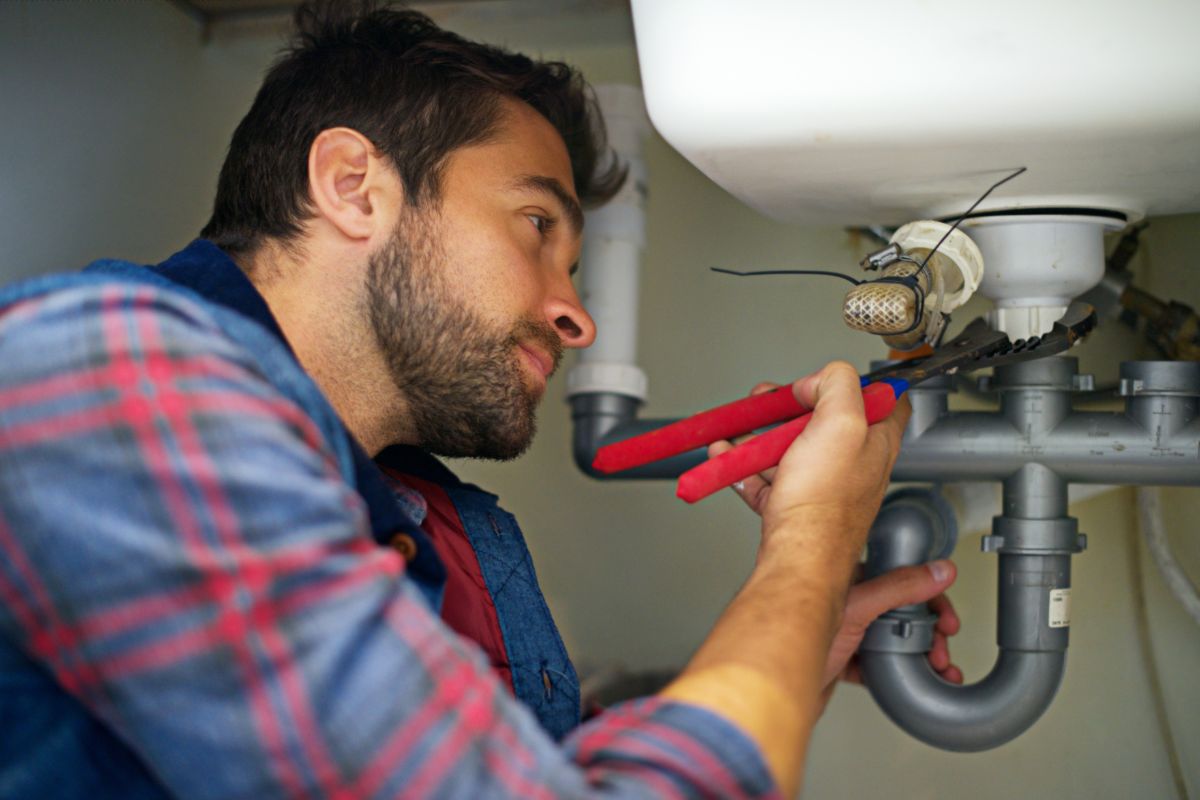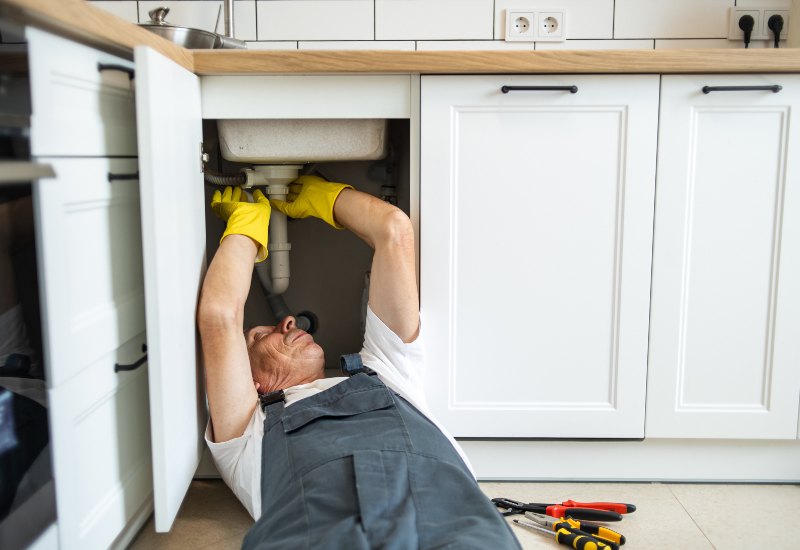Fixing a leaky pipe can be a daunting task. It often requires expertise and the right tools.
A reliable plumber can be your best ally in such situations. They bring the skills and experience needed to address pipe issues effectively. Whether it’s a minor leak or a major burst, a professional plumber ensures the problem is fixed correctly.
Understanding the basics of what a plumber does can help you appreciate their role. It also prepares you for the process and what to expect. In this blog, we explore the crucial role of plumbers in fixing pipes. We’ll highlight common pipe problems and how plumbers tackle them. This will give you a clear picture of their work and why their expertise is invaluable.

Credit: www.123rf.com
Common Plumbing Issues
We’ve all been there: the dreaded drip of a leaky faucet or the frustrating moment when water refuses to go down the drain. Common plumbing issues can turn a good day into a headache. But don’t worry, understanding these problems can help you take action quickly. Let’s dive into two of the most common plumbing problems you might face: leaky faucets and clogged drains.
Leaky Faucets
Drip, drip, drip. That sound can drive anyone up the wall. Leaky faucets are not just annoying, they can also waste a lot of water. In fact, a single dripping faucet can waste hundreds of liters of water over time. Imagine the impact on your water bill!
So, what causes a leaky faucet? It’s usually due to worn-out washers, O-rings, or seals. These tiny parts bear the brunt of daily use and eventually wear down. Replacing them is a simple task that can save you a lot of trouble.
Here’s a quick guide:
- Turn off the water supply.
- Disassemble the faucet.
- Replace the damaged parts.
- Reassemble and test.
Easy, right? But if you’re not comfortable doing it yourself, don’t hesitate to call a professional plumber. They can fix it in no time.
Clogged Drains
Clogged drains are another common issue. One minute you’re washing dishes, and the next you’re standing in a pool of dirty water. Yuck! Clogs usually happen because of hair, soap scum, or food particles building up in the pipes.
Here are some tips to prevent and fix clogged drains:
- Use a drain cover to catch hair and food particles.
- Pour boiling water down the drain weekly to clear minor clogs.
- Use a plunger or a plumber’s snake for tougher clogs.
And a little humor: if all else fails, remember that a clogged drain is just the universe’s way of telling you to take a break from cleaning!
In all seriousness, dealing with plumbing issues can be a hassle, but with a bit of knowledge and the right tools, you can tackle these common problems with confidence. And if things get too tricky, your friendly neighborhood plumber is just a phone call away.
Tools Every Plumber Needs
When it comes to fixing pipes, every plumber needs the right tools. Imagine trying to bake a cake without a whisk or a mixing bowl – it would be nearly impossible! The same goes for plumbing. Without the right tools, a plumber’s job would be much harder. So, let’s dive into some of the essential tools that every plumber should have.
Wrenches
Wrenches are like the bread and butter of a plumber’s toolkit. They come in different shapes and sizes, each serving a unique purpose.
- Pipe Wrench: This is the big daddy of wrenches. It’s used for gripping and turning pipes. Its adjustable jaws make it perfect for pipes of various sizes.
- Adjustable Wrench: Also known as a crescent wrench, this tool is perfect for nuts and bolts. Its adjustable jaw makes it versatile and handy for different tasks.
Why are wrenches so important? Well, think of them as the trusty sidekick that every hero needs. Without them, a plumber would struggle to tighten or loosen pipes and fittings.
Pipe Cutters
Next up, we have pipe cutters. These tools are essential when you need to cut pipes to the right length. Let’s take a closer look:
- Tube Cutter: This tool is specifically designed for cutting pipes. It makes a clean, smooth cut, which is crucial for ensuring a good fit.
- Hacksaw: While not as precise as a tube cutter, a hacksaw is a versatile tool that can cut through metal pipes. It’s a handy tool for those tougher jobs.
Cutting pipes may not sound glamorous, but it’s a crucial part of the job. A clean cut means a better fit and fewer leaks – and that’s what we all want, right?
Having the right tools is not just about making the job easier; it’s about doing the job right. So, next time you see a plumber at work, take a moment to appreciate the tools that help them keep our pipes in tip-top shape!
Identifying Pipe Leaks
Picture this: you’re sitting comfortably at home, enjoying your favorite TV show, when suddenly you notice a strange stain on the ceiling or a musty smell in the air. These could be signs of a pipe leak. Spotting leaks early can save you a lot of trouble and money. But how do you identify them? Let’s dive into some key indicators like water stains and unusual odors to help you out.
Water Stains
Have you seen discolored spots on your walls or ceilings? These water stains can be a telltale sign of a leaky pipe. Water travels through your home and leaves stains behind. Look for:
- Brown or yellow patches
- Bubbling paint or wallpaper
- Warped areas on walls or floors
Checking these areas regularly can help you catch leaks early. Better safe than sorry, right?
Unusual Odors
Ever walked into a room and thought, “What’s that smell?” Unusual odors can be a red flag for pipe leaks. Water leaks can create damp spots where mold and mildew thrive. This leads to musty or earthy smells that signal trouble. Keep an eye out for:
- Persistent musty smells
- Strange odors even after cleaning
- A sudden increase in insects or pests
These smells might seem harmless, but they can indicate a bigger issue. Trust your nose!
Identifying pipe leaks can seem daunting, but with these simple tips, you can stay ahead of potential problems. Remember, early detection is key. If you suspect a leak, don’t hesitate to call in a professional plumber. After all, peace of mind is priceless!

Credit: supremepipe.com
Temporary Fixes For Leaks
Dealing with a leaking pipe can be a stressful situation. Temporary fixes can help you manage the issue until a professional plumber arrives. Simple materials can often stop a leak quickly and effectively. Below are some temporary fixes for leaks that you can try at home.
Pipe Tape
Pipe tape, also known as plumber’s tape, is a quick fix for leaks. Wrap the tape around the leaking area to seal it. The tape is flexible and sticks well to the pipe. This method works best for small leaks. Make sure the pipe is dry before applying the tape. This ensures the tape adheres properly.
Epoxy Putty
Epoxy putty is another effective solution for temporary pipe repairs. It comes in a moldable form that hardens after application. To use epoxy putty, knead it until it’s soft and then apply it to the leak. Ensure the surface is clean and dry before use. Epoxy putty can seal larger leaks and lasts longer than tape. Once it hardens, it forms a strong bond that holds up well until a professional can fix the pipe.
Steps To Fix A Leaky Pipe
Fixing a leaky pipe can seem like a daunting task, especially for those who are not familiar with plumbing. However, with a little bit of guidance, it is possible to repair a pipe without professional help. Below are the steps you need to follow to fix a leaky pipe. Read on to learn more!
Turn Off Water Supply
Before you start, it is important to turn off the water supply. This step is crucial to avoid water flooding your home. Locate the main water valve and turn it off. If you can’t find it, check under the sink or near the water meter. Once the water is off, open a faucet to drain any remaining water in the pipes.
Replace The Damaged Section
Once the water supply is off, you need to replace the damaged section of the pipe. Here’s how to do it:
- Cut out the damaged part: Use a pipe cutter to remove the leaky section. Make sure your cuts are clean and straight.
- Measure and cut the new pipe: Measure the length of the removed section and cut a new piece of pipe to match.
- Fit the new pipe: Use pipe connectors to attach the new piece to the existing pipe. Ensure the connections are tight to prevent future leaks.
After replacing the damaged section, turn the water supply back on and check for any leaks. If you don’t see any, congratulations! You have successfully fixed your leaky pipe.
Remember, fixing a leaky pipe is not as hard as it seems. With these simple steps, you can save yourself the cost of hiring a plumber. Happy fixing!
Preventing Future Leaks
A plumber fixing a pipe ensures future leaks are prevented. Regular maintenance and timely repairs keep your plumbing system in top condition.
Preventing future leaks is crucial for maintaining your home’s plumbing. Regular inspections and proper pipe insulation can help.Regular Inspections
Regular inspections of your plumbing system can catch small issues early. Small leaks often become big problems. A plumber can check for weak spots. They can ensure all pipes are in good shape. This can save you from unexpected repairs. Regular checks also help in maintaining water pressure.Proper Pipe Insulation
Proper pipe insulation is essential to prevent leaks. Insulated pipes are protected from temperature changes. This helps in reducing the risk of cracks. Insulation also keeps pipes from freezing in winter. It helps in maintaining consistent water temperature. Using the right insulation material is key. A plumber can recommend the best options for your home. “`When To Call A Professional
Sometimes, plumbing issues can be fixed with DIY methods. But there are moments when professional help is necessary. Knowing when to call a plumber can save you time and money. Let’s explore some key situations where expert intervention is essential.
Complex Repairs
Some plumbing problems are too complex for DIY solutions. Issues like major pipe leaks or broken pipes need professional tools and skills. Attempting these repairs without expertise can worsen the situation. It can also cause more damage to your plumbing system. Always trust a plumber for these intricate tasks.
Persistent Issues
Recurring problems can indicate underlying issues. If a pipe keeps leaking despite numerous fixes, a professional inspection is crucial. Persistent clogs also need expert attention. They might signal a deeper blockage in your system. Ignoring these signs can lead to severe damage and costly repairs.
Maintaining Your Plumbing System
Plumbing issues can be a real headache. One day, everything is fine, and the next, you’re ankle-deep in water. But don’t worry! Regular maintenance can save you from costly repairs and keep your plumbing system in top shape. Let’s dive into some easy tips for keeping things flowing smoothly.
Routine Maintenance
Routine maintenance is crucial for a healthy plumbing system. Think of it like brushing your teeth—simple actions that prevent big problems.
- Check for Leaks: Look under sinks and around toilets for any signs of moisture. Even a small leak can cause big damage over time.
- Clean Drains: Use a drain cleaner or a simple mix of baking soda and vinegar to keep your pipes clear. Clogged drains are a common issue but easily preventable.
- Inspect Water Pressure: High water pressure can damage pipes. Use a pressure gauge to check and adjust if necessary.
Seasonal Tips
Different seasons bring different challenges for your plumbing. Here are some tips to keep in mind throughout the year.
- Winter: Prevent frozen pipes by insulating them and keeping your home warm. Let faucets drip a little on extra cold nights.
- Spring: Check for leaks and inspect outdoor faucets. Winter can be harsh on your plumbing, so it’s good to do a thorough check.
- Summer: Be mindful of what you put down the garbage disposal. Summer barbecues can lead to a lot of food waste, which can clog your pipes.
- Fall: Clear out gutters and downspouts. Falling leaves can clog your drainage system and lead to water damage.
Remember, a little maintenance goes a long way. By taking these simple steps, you can avoid the hassle and expense of major plumbing repairs. And who doesn’t want that?

Credit: pugetsoundplumbing.com
Frequently Asked Questions
Can A Plumber Fix A Broken Pipe?
Yes, a plumber can fix a broken pipe. They have the skills and tools to repair or replace damaged pipes efficiently.
Do Plumbers Do Pipe Fitting?
Yes, plumbers do pipe fitting. They install, repair, and maintain piping systems in residential and commercial buildings.
What Do You Call A Pipe Fixer?
A pipe fixer is called a plumber. Plumbers install, repair, and maintain pipes and plumbing systems. They handle water, gas, and drainage systems.
How Long Does It Take A Plumber To Fix A Pipe?
A plumber typically takes 1-3 hours to fix a pipe, depending on the complexity of the issue.
Conclusion
A well-fixed pipe ensures peace of mind. No more leaks. No more worries. Trust your local plumber for any pipe issues. Quick fixes save money and prevent damage. Always choose a professional for reliable results. Your home deserves the best care.
Keep plumbing systems in top shape. Regular maintenance can avoid future problems. Thanks for reading. Stay informed, stay safe.
